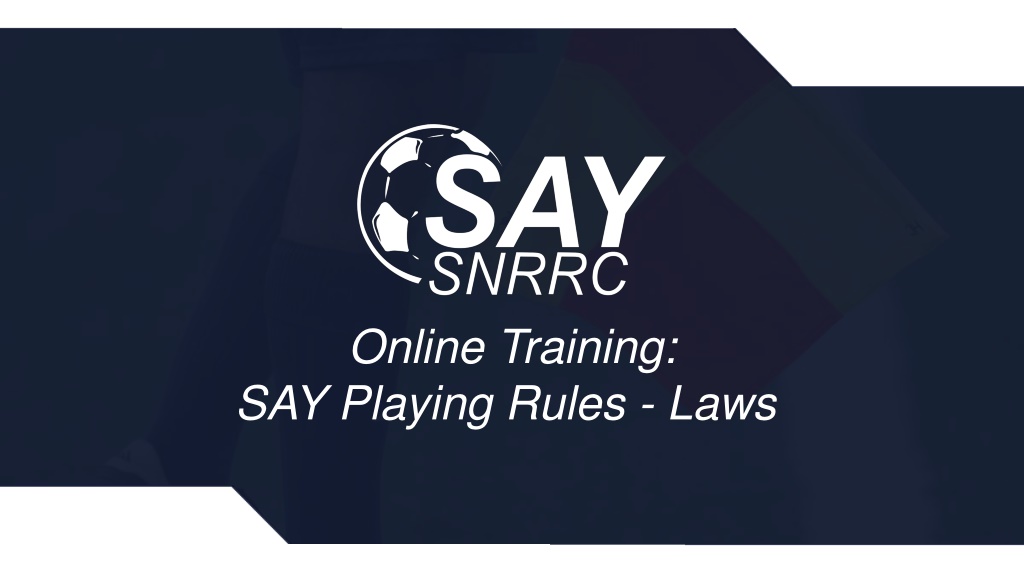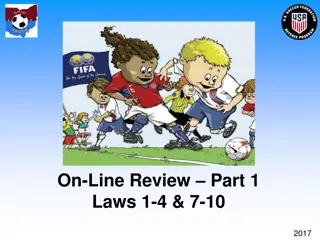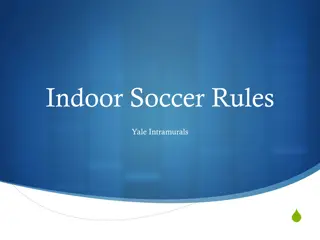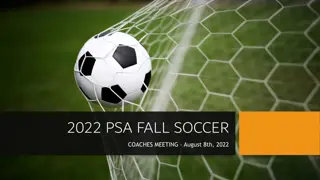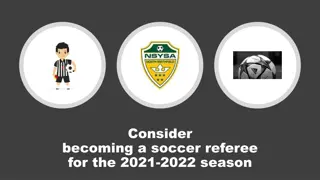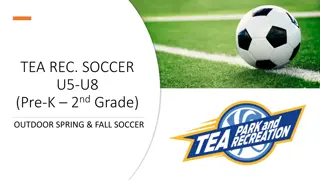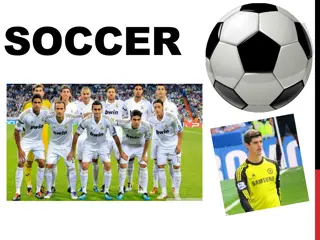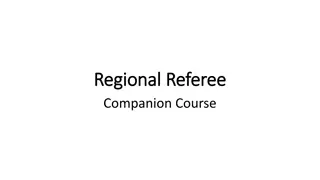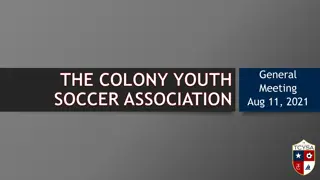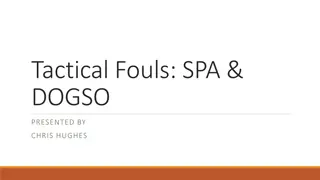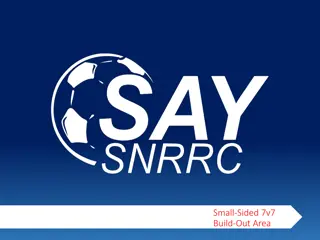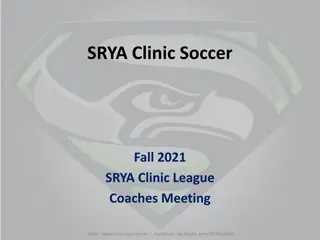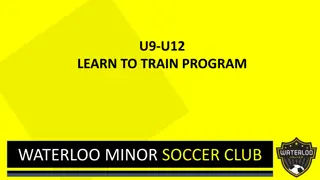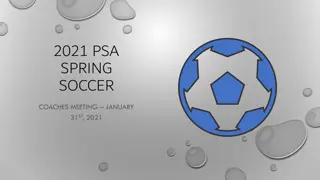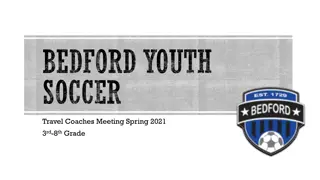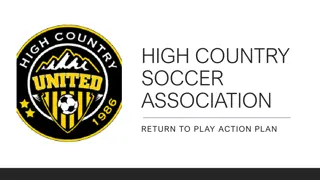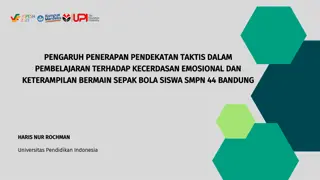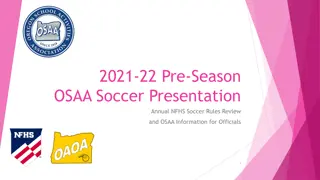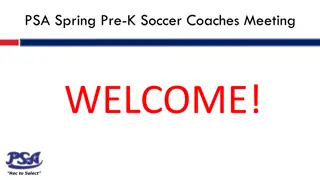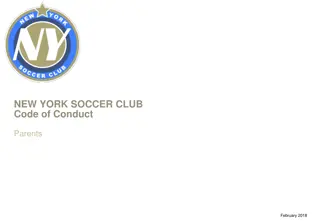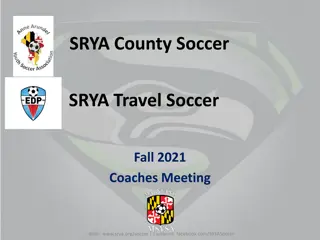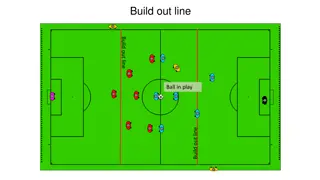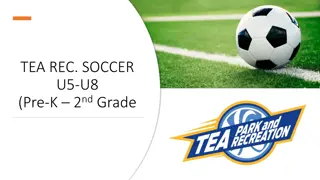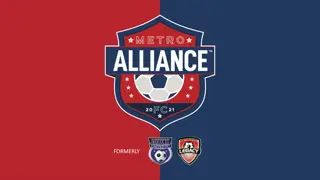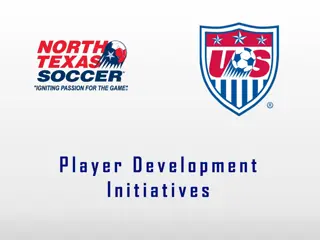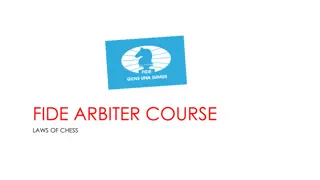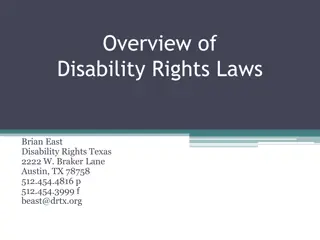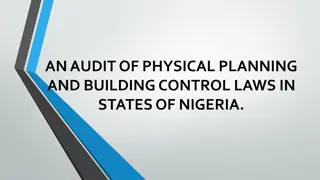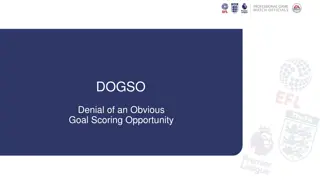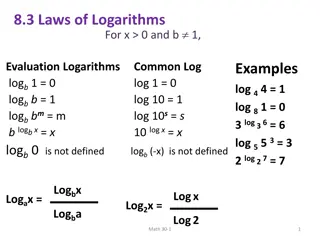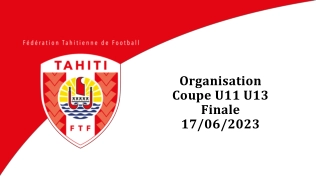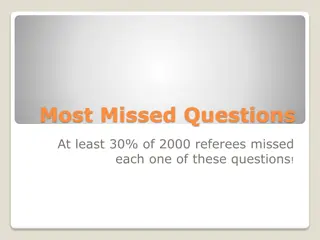Understanding SAY Soccer Playing Rules and Laws
Explore Section 3 of SAY Soccer's online training course for officials, diving into the playing rules and laws related to Laws 7-10 and 15-17. Learn about game periods, kick-offs, timekeeping responsibilities of referees, intervals between periods, allowances for lost time, and more. Get a comprehensive insight into the fundamental aspects governing gameplay in SAY Soccer.
Download Presentation

Please find below an Image/Link to download the presentation.
The content on the website is provided AS IS for your information and personal use only. It may not be sold, licensed, or shared on other websites without obtaining consent from the author. Download presentation by click this link. If you encounter any issues during the download, it is possible that the publisher has removed the file from their server.
E N D
Presentation Transcript
Online Training: SAY Playing Rules - Laws
SECTION 3 Welcome to Section 3 of SAY Soccer s online training course for SAY Soccer Officials. In the third section of the online training course you will learn How To Play The Game, through the review of the SAY Playing Rules - Laws 7-10 and 15-17 How To Play The Game
SECTION 3: How To Play The Game Law - 10 Law- 16 Law - 17 Law - 9 Law - 7 Law - 8 Law - 15 Law - 10 Law- 16 Law - 17 Law - 9 Law - 7 Law - 8 Law - 15 PERIODS OF PLAY All games will be played in periods of either four (4) equal quarters or two (2) equal halves, as determined by the leagues. Each period is to begin with a kick-off. Teams will change ends at the beginning of each period. Teams will alternate kicking off at the beginning of each period. The team kicking off in the 1st quarter will kick-off in the 3rd quarter. The team kicking off in the 2nd quarter will kick-off in the 4th quarter. Duration Of The Game Progress:
SECTION 3: How To Play The Game Law - 10 Law- 16 Law - 17 Law - 9 Law - 7 Law - 8 Law - 15 Law - 10 Law- 16 Law - 17 Law - 9 Law - 7 Law - 8 Law - 15 TIME OF PERIODS Time of play shall be kept by and is solely the responsibility of the Referee(s). Duration Of The Game Progress:
SECTION 3: How To Play The Game Law - 10 Law- 16 Law - 17 Law - 9 Law - 7 Law - 8 Law - 15 Law - 10 Law- 16 Law - 17 Law - 9 Law - 7 Law - 8 Law - 15 INTERVAL BETWEEN PERIODS Intervals between the 1st and 2nd, and the 3rd and 4th quarters will be one (1) minute. The half-time interval will be five (5) minutes. ALLOWANCE FOR TIME LOST Allowances shall be made within each period for time lost through injury or other cause. The amount of time added shall be at the discretion of the Referee. The time to be added shall be at the end of a period. This time may not be added to a different period. END OF PLAY Play ends exactly at the instant that time for the period runs out: including any time which has been added, regardless of the position or motion of the ball at that moment. Duration Of The Game Progress:
SECTION 3: How To Play The Game Law - 10 Law- 16 Law - 17 Law - 9 Law - 7 Law - 8 Law - 15 Law - 10 Law- 16 Law - 17 Law - 9 Law - 7 Law - 8 Law - 15 PRELIMINARIES Prior to the game, choice of ends shall be determined by a coin toss. The team winning the toss will choose: to take the kick-off in the first quarter (or half), or which goal it will attack during the first quarter (or half). The other team will make the remaining choice to start the match. Neither team may choose to take the kick- off to begin the second quarter (or half). Teams will switch ends of the field at the start of each quarter (or half). The kick-off to start each quarter (or half) will be taken by the team that did not kick off to start the previous quarter (or half). The Start & Restart Progress:
SECTION 3: How To Play The Game Law - 10 Law- 16 Law - 17 Law - 9 Law - 7 Law - 8 Law - 15 Law - 10 Law- 16 Law - 17 Law - 9 Law - 7 Law - 8 Law - 15 KICK-OFF A kick-off is the way: Until the ball is kicked, the players of each team (except for the kicker) must be in their team's half of the field, to start each quarter (or half) of the game, to restart play after a goal is scored. the players of the opposing team must also be outside the center circle. Upon the Referee's whistle, the game is started or restarted by a player taking a kick from the center mark. The player taking the kick-off may be completely in the opposing team s half of the field at the taking of the kick. The Start & Restart Progress:
SECTION 3: How To Play The Game Law - 10 Law- 16 Law - 17 Law - 9 Law - 7 Law - 8 Law - 15 Law - 10 Law- 16 Law - 17 Law - 9 Law - 7 Law - 8 Law - 15 START OF PLAY On a kick-off, the ball is in-play when it is kicked and clearly moves in any direction. The kicker may not touch the ball a second time until it has been touched by another player from either team. If the ball is touched or played twice in succession, an indirect free kick (IFK) is awarded to the opposing team at the place where it was touched the second time. The Start & Restart Progress:
SECTION 3: How To Play The Game Law - 10 Law- 16 Law - 17 Law - 9 Law - 7 Law - 8 Law - 15 Law - 10 Law- 16 Law - 17 Law - 9 Law - 7 Law - 8 Law - 15 GOAL FROM KICK-OFF AFTER GOAL After a goal has been scored, the game is restarted with a kick-off by the team scored against. A goal may be scored directly (first touch) against the opposing team from a kick-off. A team may not score a goal against itself directly from a kick-off. If the ball is kicked directly into the kicker s own goal, a corner kick is awarded to the opposing team. The Start & Restart Progress:
SECTION 3: How To Play The Game Law - 10 Law- 16 Law - 17 Law - 9 Law - 7 Law - 8 Law - 15 Law - 10 Law- 16 Law - 17 Law - 9 Law - 7 Law - 8 Law - 15 DROPPED BALL RESTART A dropped ball is the way to restart play where it is necessary for the Referee to temporarily stop a game, while the ball was in-play, when: a player is injured, an outside agent interferes with play, the ball that touches a Referee or Assistant Referee on the field-of-play interferes with play, the whistle is accidently blown by the Referee, on any other occasion not mentioned elsewhere in these Laws. The Start & Restart Progress:
SECTION 3: How To Play The Game Law - 10 Law- 16 Law - 17 Law - 9 Law - 7 Law - 8 Law - 15 Law - 10 Law- 16 Law - 17 Law - 9 Law - 7 Law - 8 Law - 15 DROPPED BALL RESTART Only one player may take part in the dropped ball restart. All other players (both teams) must be at least 4-yards away. The ball shall always be dropped to the defending team s goalkeeper in their Penalty Area if, when play was stopped: the ball was in the Penalty Area, or the last touch of the ball was in the Penalty Area. Opposing players are not required to leave the Penalty Area when a dropped ball occurs. The Start & Restart Progress:
SECTION 3: How To Play The Game Law - 10 Law- 16 Law - 17 Law - 9 Law - 7 Law - 8 Law - 15 Law - 10 Law- 16 Law - 17 Law - 9 Law - 7 Law - 8 Law - 15 DROPPED BALL RESTART If the stoppage occurs when the ball is within the Goal Area, it shall be dropped to the goalkeeper on that part of the Goal Area line nearest to where the ball was when play was stopped. If play is stopped outside the Penalty Area, the Referee shall: drop the ball to a player of the team that last touched the ball and the ball is to be dropped at the location where it last touched either: 1) a player, 2) an outside agent , or 3) a Referee or Assistant Referee. The Start & Restart Progress:
SECTION 3: How To Play The Game Law - 10 Law- 16 Law - 17 Law - 9 Law - 7 Law - 8 Law - 15 Law - 10 Law- 16 Law - 17 Law - 9 Law - 7 Law - 8 Law - 15 DROPPED BALL IN-PLAY A dropped ball shall be in-play when it touches the ground. If a player touches the ball before it contacts the ground, the Referee shall drop the ball again. If a dropped ball leaves the field-of-play before being touched by any player, the Referee shall redo the dropped ball. The player receiving the dropped ball may play it as many times in succession as they so choose. The Start & Restart Progress:
SECTION 3: How To Play The Game Law - 10 Law- 16 Law - 17 Law - 9 Law - 7 Law - 8 Law - 15 Law - 10 Law- 16 Law - 17 Law - 9 Law - 7 Law - 8 Law - 15 GOAL FROM DROPPED BALL In order for a goal to be scored the ball must be touched by at least two different players, i.e. from either team. If the ball goes into the goal after it has been dropped and only one player has touched the ball (regardless of the number of touches): a goal cannot be awarded, and play is to be restarted with either a goal kick or corner kick. The Start & Restart Progress:
SECTION 3: How To Play The Game Law - 10 Law- 16 Law - 17 Law - 9 Law - 7 Law - 8 Law - 15 Law - 10 Law- 16 Law - 17 Law - 9 Law - 7 Law - 8 Law - 15 OTHER RESTARTS Direct free kick (DFK), indirect free kick (IFK) and penalty kick (PK) restarts shall be awarded: for fouls and misconduct offenses covered in Law 12, only when the Referee stops play for these offenses committed while the ball is in-play, in accordance with the procedures defined in Laws 13 & 14. Whenever the ball leaves the field, play will be restarted with either a throw-in, goal kick or corner kick as per Laws 15, 16 & 17. Any offense that occurs when the ball is out-of-play does not change how play is restarted. The Start & Restart Progress:
SECTION 3: How To Play The Game Law - 10 Law- 16 Law - 17 Law - 9 Law - 7 Law - 8 Law - 15 Law - 10 Law- 16 Law - 17 Law - 9 Law - 7 Law - 8 Law - 15 SMALL-SIDED 7v7 RESTARTS All Passers (U-8) and Wings (U-10) games shall be played using the following Build-Out Area rules: The players of the opposing team must move outside the Build-Out Area: on all goal kicks, and on any defensive free kick (DFK or IFK) taken from within the Build-Out Area, and whenever the goalkeeper, during play, gains possession of the ball with their hands within their Penalty Area. The opposing team s players must also move at least 8-yards from the ball on any free kick taken from within the Build-Out Area. The players of the opposing team must remain outside the Build-Out Area (and at least 8-yards from the ball) until the ball is put back into play. The Start & Restart Progress:
SECTION 3: How To Play The Game Law - 10 Law- 16 Law - 17 Law - 9 Law - 7 Law - 8 Law - 15 Law - 10 Law- 16 Law - 17 Law - 9 Law - 7 Law - 8 Law - 15 SMALL-SIDED 7v7 RESTARTS The ball is back in-play: 1) on goal kicks when the ball is kicked and clearly moves in any direction, or 2) on free kicks (DFK or IFK) when the ball is kicked and clearly moves in any direction, or 3) on goalkeeper possession when the goalkeeper releases the ball by either: a) throwing it into play, or b) rolling it into play, or c) placing the ball on the ground and kicking it. The Start & Restart Progress:
SECTION 3: How To Play The Game Law - 10 Law- 16 Law - 17 Law - 9 Law - 7 Law - 8 Law - 15 Law - 10 Law- 16 Law - 17 Law - 9 Law - 7 Law - 8 Law - 15 SMALL-SIDED 7v7 RESTARTS Goalkeepers are not allowed to punt or drop-kick the ball and if they do: an indirect free kick (IFK) is awarded to the opposing team, and the IFK will be taken at the spot of the punt/drop-kick (or pull out to the goal area line).. Goalkeepers have six (6) seconds to put the ball back into play: once the ball is in their possession, and the counting of time should only begin when all opponents have moved outside the Build-Out Area. The Start & Restart Progress:
SECTION 3: How To Play The Game Law - 10 Law- 16 Law - 17 Law - 9 Law - 7 Law - 8 Law - 15 Law - 10 Law- 16 Law - 17 Law - 9 Law - 7 Law - 8 Law - 15 SMALL-SIDED 7v7 RESTARTS Once the ball is put back into play, the opposing players may then move into the Build-Out Area and play resumes as normal. Opposing players who enter the Build-Out Area before the ball is put back into play are guilty of encroachment. When the Referee stops play for encroachment, play is restarted by the kicking team with an indirect free kick (IFK) at the spot of the encroachment. The Start & Restart Progress:
SECTION 3: How To Play The Game Law - 10 Law- 16 Law - 17 Law - 9 Law - 7 Law - 8 Law - 15 Law - 10 Law- 16 Law - 17 Law - 9 Law - 7 Law - 8 Law - 15 BALL OUT-OF-PLAY The ball is out-of-play when: the whole of the ball completely passes over the Goal Line or Touchline, whether on the ground or in the air, when the game has been stopped by the Referee, including when the Referee accidently blows the whistle, the ball touches the Referee or Assistant Referee without completely leaving the field-of-play and: 1) either team starts a promising attack, or 2) the ball goes directly into the goal, or 3) the team in possession of the ball changes, or 4) the ball significantly changes direction. Ball In & Out Of Play Progress:
SECTION 3: How To Play The Game Law - 10 Law- 16 Law - 17 Law - 9 Law - 7 Law - 8 Law - 15 Law - 10 Law- 16 Law - 17 Law - 9 Law - 7 Law - 8 Law - 15 BALL IN-PLAY The ball is in-play at all other times, including when: 1) it rebounds from a goal post, cross bar or corner flag and remains in the field-of-play, or 2) there is an apparent infringement, but no signal has been given by the Referee. Ball In & Out Of Play Progress:
SECTION 3: How To Play The Game Law - 10 Law- 16 Law - 17 Law - 9 Law - 7 Law - 8 Law - 15 Law - 10 Law- 16 Law - 17 Law - 9 Law - 7 Law - 8 Law - 15 OUT-OF-PLAY The ball is out-of-play: when the ball has completely left the field-of play, including onto the goal, whenever the Referee blows the whistle and play is stopped, when the ball hits the Referee and does not leave the field, when the ball hits an object on the field that is not a part of the game, such as a ball from an adjacent field, a dog or spectator that has come onto the field, etc., when the ball hits a football-style goal post or crossbar, even if the ball stays on the field. Ball In & Out Of Play Progress:
SECTION 3: How To Play The Game Law - 10 Law- 16 Law - 17 Law - 9 Law - 7 Law - 8 Law - 15 Law - 10 Law- 16 Law - 17 Law - 9 Law - 7 Law - 8 Law - 15 GOAL SCORED Except as otherwise provided by these Laws, a goal is scored when the whole of the ball passes over the goal line, between the goal posts and under the cross bar. A goal shall not be awarded if the goalkeeper throws the ball directly into the opponent s goal. A goal shall not be awarded if it is the result of an offense by the attacking team. A goal shall not be awarded if the ball touches the Referee or Assistant Referee and then goes directly into the goal, as defined in Law 9. Method Of Scoring Progress:
SECTION 3: How To Play The Game Law - 10 Law- 16 Law - 17 Law - 9 Law - 7 Law - 8 Law - 15 Law - 10 Law- 16 Law - 17 Law - 9 Law - 7 Law - 8 Law - 15 REFEREE DECISION BALL POSITION A goal may not ever be allowed if the whole of the ball has not crossed the goal line. The Referee may not award a goal unless in a position to observe and be certain that the ball has completely crossed the goal- line. The Referee should award a goal if an Assistant Referee is in such a position and signals that fact to the Referee. Method Of Scoring Progress:
SECTION 3: How To Play The Game Law - 10 Law- 16 Law - 17 Law - 9 Law - 7 Law - 8 Law - 15 Law - 10 Law- 16 Law - 17 Law - 9 Law - 7 Law - 8 Law - 15 INTERFERENCE If the ball touches a substitute or team official, who has come onto the field-of-play without the Referee s permission, play shall be stopped. A goal may be allowed if the ball does not change direction, continues on into the goal, and the interference does not prevent a defender from being able to play the ball. A goal shall not be allowed if it never enters the goal. A goal shall not be allowedif the ball enters the opponent s goal. The game shall be restarted with a direct free kick (DFK) or penalty kick (PK) depending upon where the interference occurred. Method Of Scoring Progress:
SECTION 3: How To Play The Game Law - 10 Law- 16 Law - 17 Law - 9 Law - 7 Law - 8 Law - 15 Law - 10 Law- 16 Law - 17 Law - 9 Law - 7 Law - 8 Law - 15 OUTSIDE AGENT If the ball is stopped by an outside agent play shall be stopped. An outside agent is defined as anyone not listed as a player, substitute or team official on the team s roster. A ball, any other object or an animal (i.e. a dog) are also considered to be outside agents. The game shall be restarted appropriately in accordance with Law 8, at the place where the ball touched the outside agent . The Referee or Assistant Referees are not outside agents Method Of Scoring Progress:
SECTION 3: How To Play The Game Law - 10 Law- 16 Law - 17 Law - 9 Law - 7 Law - 8 Law - 15 Law - 10 Law- 16 Law - 17 Law - 9 Law - 7 Law - 8 Law - 15 OUTSIDE AGENT A goal may be allowed (even when contact is made with the ball) if the ball: Is going into the goal, and does not change direction, and the interference does not prevent a defender from being able to play the ball. A goal shall not be allowedif the ball s direction is changed causing it to enter the goal. A goal shall not be allowedif the ball that touches an outside agent never enters the goal. Method Of Scoring Progress:
SECTION 3: How To Play The Game Law - 10 Law- 16 Law - 17 Law - 9 Law - 7 Law - 8 Law - 15 Law - 10 Law- 16 Law - 17 Law - 9 Law - 7 Law - 8 Law - 15 WINNING TEAM The team scoring more goals shall be the winner. If both teams score an equal number of goals, or if no goals are scored, the game shall be a draw. Method Of Scoring Progress:
SECTION 3: How To Play The Game Law - 10 Law- 16 Law - 17 Law - 9 Law - 7 Law - 8 Law - 15 Law - 10 Law- 16 Law - 17 Law - 9 Law - 7 Law - 8 Law - 15 THROW-IN RESTART When the whole of the ball has passed over a Touchline, either on the ground or in the air, it shall be put back into play: By a player of the opposing team to that of the player who touched it last. By a throw-in taken in any direction. At the point where the ball left the field-of-play. Throw-In Progress:
SECTION 3: How To Play The Game Law - 10 Law- 16 Law - 17 Law - 9 Law - 7 Law - 8 Law - 15 Law - 10 Law- 16 Law - 17 Law - 9 Law - 7 Law - 8 Law - 15 PROCEDURE At the moment of delivering the ball the thrower: Must face-the-field of play and with part of each foot shall be: either on the Touchline, or on the ground outside the Touchline, and part of each foot shall be in contact with the ground Throw-In Progress:
SECTION 3: How To Play The Game Law - 10 Law- 16 Law - 17 Law - 9 Law - 7 Law - 8 Law - 15 Law - 10 Law- 16 Law - 17 Law - 9 Law - 7 Law - 8 Law - 15 BALL IN-PLAY The ball shall be in-play immediately upon any part of the ball breaking the plane of the field-of-play (i.e. the outside edge of the Touchline) and after having been released by the thrower. The thrower may not again touch or play the ball until it has been touched by another player from either team. Throw-In Progress:
SECTION 3: How To Play The Game Law - 10 Law- 16 Law - 17 Law - 9 Law - 7 Law - 8 Law - 15 Law - 10 Law- 16 Law - 17 Law - 9 Law - 7 Law - 8 Law - 15 SECOND TOUCH If a player taking a throw-in touches the ball after it has been thrown before it is touched by another player, an indirect free kick (IFK) shall be awarded to the opposing team. The IFK will be taken from the place where the second touch occurred. If a player taking a throw-in touches the ball after it has been thrown before it is touched by another player, an indirect free kick (IFK) shall be awarded to the opposing team. The IFK will be taken from the place where the second touch occurred. OFFSIDE The Offside Law 11 does not apply at the taking of a throw-in. Throw-In Progress:
SECTION 3: How To Play The Game Law - 10 Law- 16 Law - 17 Law - 9 Law - 7 Law - 8 Law - 15 Law - 10 Law- 16 Law - 17 Law - 9 Law - 7 Law - 8 Law - 15 GOAL KICK RESTART When the ball passes completely over the defending team s goal line, last touched by an attacking player, and a goal was not scored, it shall be put into play: By a kick taken by a player of the defending team. From a point anywhere within the Goal Area. Goal Kick Progress:
SECTION 3: How To Play The Game Law - 10 Law- 16 Law - 17 Law - 9 Law - 7 Law - 8 Law - 15 Law - 10 Law- 16 Law - 17 Law - 9 Law - 7 Law - 8 Law - 15 OPPENENT S POSITION All players of the opposing team shall move and remain outside the Penalty Area until the ball has been kicked and clearly moves. The goal kick is to be retaken if an opponent: is in the Penalty Area or enters the Penalty Area before the ball is in-play, and then touches or challenges for the ball before it has touched another player. SMALL-SIDED: In the Passers (8-U) and Wings (10-U) divisions all opposing players shall move and remain outside the Build-Out Area until the ball has been kicked and clearly moves [See Law 8]. The goal kick is to be retaken if an opponent: is in the Build-Out Area or enters the Build-Out Area before the ball is in play, and touches or challenges for the ball before it has touched another player. Goal Kick Progress:
SECTION 3: How To Play The Game Law - 10 Law- 16 Law - 17 Law - 9 Law - 7 Law - 8 Law - 15 Law - 10 Law- 16 Law - 17 Law - 9 Law - 7 Law - 8 Law - 15 SECOND TOUCH If a player taking a goal kick touches the ball after it has been kicked, but before it is touched by another player, an indirect free kick (IFK) shall be awarded to the opposing team. The IFK will be taken from the place where the second touch occurred. Goal Kick Progress:
SECTION 3: How To Play The Game Law - 10 Law- 16 Law - 17 Law - 9 Law - 7 Law - 8 Law - 15 Law - 10 Law- 16 Law - 17 Law - 9 Law - 7 Law - 8 Law - 15 GOAL SCORED A goal may be scored directly (first touch) from a goal-kick, but only against the opposing team. A team cannot score against itself directly from a goal kick. If ball is kicked directly into a team s own goal, the opposing team will restart play with a corner kick. OFFSIDE The Offside Law 11 does not apply at the taking of a throw-in. Goal Kick Progress:
SECTION 3: How To Play The Game Law - 10 Law- 16 Law - 17 Law - 9 Law - 7 Law - 8 Law - 15 Law - 10 Law- 16 Law - 17 Law - 9 Law - 7 Law - 8 Law - 15 CORNER KICK When the ball goes over the goal line last touched by a member of the defending team, the restart should benefit the attacking team in some small way. The game offers them a free kick from on or within the corner arc. Corner Kick Progress:
SECTION 3: How To Play The Game Law - 10 Law- 16 Law - 17 Law - 9 Law - 7 Law - 8 Law - 15 Law - 10 Law- 16 Law - 17 Law - 9 Law - 7 Law - 8 Law - 15 IT S A SPECIAL RESTART Referees must remember that a corner kick, like a goal kick or penalty kick, is a very specialized kick restart. It has its own Law 17, but many of the characteristics of a free kick restart (Law 13) are the same: 1) the ball must be stationary, 2) the kicker may not play the ball twice in succession, 3) the opponents must be at least 10-yards [8-yards for small-sided Passers (8-U), Wings (10-U) and Strikers (12-U)] from the corner arc, etc. Do not allow the opponents within 10-yards of the corner kick, any more than you would allow them to get within 10-yards of a direct free kick (DFK) or indirect free kick (IFK). Corner Kick Progress:
SECTION 3: How To Play The Game Law - 10 Law- 16 Law - 17 Law - 9 Law - 7 Law - 8 Law - 15 Law - 10 Law- 16 Law - 17 Law - 9 Law - 7 Law - 8 Law - 15 Referees who position themselves in the same place for each corner kick can generate problems. Skilled and devious players will soon recognize the pattern and capitalize upon your habit. Players then find the area where they can commit a foul to gain an advantage out of your sight. Therefore, it is recommended that you vary your positioning occasionally during the match. The Lead Referee may move behind the kicker or up along the goal line. The Trail Referee may pull up to the far upper edge of the penalty area or a few yards above the penalty arc. REFEREE POSITIONING Teams are developing new tactical approaches to taking corner kicks and referees need to stay up-to-date about how to deal effectively with them. The "short corner" is a good example. Appearing in World Cup play for the first time in 1994, referees were at first unsure about the best position they should take and what each should be watching for An offside violation can more easily occur and be missed, i.e. not seen by the referees, in a short corner kick situation. Corner Kick Progress:
SECTION 3: How To Play The Game Law - 10 Law- 16 Law - 17 Law - 9 Law - 7 Law - 8 Law - 15 Law - 10 Law- 16 Law - 17 Law - 9 Law - 7 Law - 8 Law - 15 READ PLAY Look at what teams have been done earlier in the game to get clues about what they might do. Factor in the score and the time remaining. Realize that substitution patterns may alter what teams attempt to do during corner kicks. Because professional teams are starting to bring goalkeepers the length of the field during corner kicks, look for teams in your area to start mimicking those tactics. Corner Kick Progress:
SECTION 3: How To Play The Game Law - 10 Law- 16 Law - 17 Law - 9 Law - 7 Law - 8 Law - 15 Law - 10 Law- 16 Law - 17 Law - 9 Law - 7 Law - 8 Law - 15 GOALKEEPERS Goalkeepers present a wonderful challenge for referees during corner kicks. The Laws of the Game offer them no special protection. Their coaches, teammates and fans will cry, protest and demand they be protected. Many referees interpret the Spirit of the Game to infer that goalkeepers should be given that little edge in a 50-50 contest. Are you one of those? If you are, it deserves some additional thought. It should not be done automatically. Corner Kick Progress:
SECTION 3: How To Play The Game Law - 10 Law- 16 Law - 17 Law - 9 Law - 7 Law - 8 Law - 15 Law - 10 Law- 16 Law - 17 Law - 9 Law - 7 Law - 8 Law - 15 GOALKEEPERS Your stock as a referee and game manager can soar in the eyes of the defenders when you appropriately handle an attacker roughing up a goalkeeper. Watch for someone fronting the keeper and moving their heels continuously. They are trying to "accidentally" step on the keeper's toes with one of two thoughts in mind: Get the keeper's mind focused on the painful toes instead of the ball heading goal-ward, or Get the keeper to retaliate with a push in full view of the referee. Goalkeepers also become very aggressive in their endeavor to keep a clean slate. They will go over and through players to punch or collect the ball. Sometimes their aggressiveness is careless or reckless. Corner Kick Progress:
SECTION 3: How To Play The Game Law - 10 Law- 16 Law - 17 Law - 9 Law - 7 Law - 8 Law - 15 Law - 10 Law- 16 Law - 17 Law - 9 Law - 7 Law - 8 Law - 15 GOALKEEPERS As the Referee you must try to bring a balance to those actions. Your positioning to see all those subtle dramas is a great start. A well-spoken word of warning, as soon as such actions start, places you in firm control. An authoritative whistle, as soon as the actions become careless, lets everyone know where the limits are during the later stages of the game. For those few who do not heed your earlier messages, a card may turn out to be your moment of truth when you demonstrate you will act as needed for player's safety. Corner Kick Progress:
SECTION 3: How To Play The Game Law - 10 Law- 16 Law - 17 Law - 9 Law - 7 Law - 8 Law - 15 Law - 10 Law- 16 Law - 17 Law - 9 Law - 7 Law - 8 Law - 15 ASSESSORS Assessors may share information about how they handle corner kicks. There is no one right location. If an assessor dictates that you take a certain location during a post-game debrief, listen to the comment, say "Thank you very much" after their debrief and then use common sense positioning based on your reading of the play. Any discussions you may have with assessors will increase your knowledge of the game and your awareness of positioning. There are rumors that some assessors will tell you where you must stand during the taking of corner kicks. Corner Kick Progress:
SECTION 3: How To Play The Game Law - 10 Law- 16 Law - 17 Law - 9 Law - 7 Law - 8 Law - 15 Law - 10 Law- 16 Law - 17 Law - 9 Law - 7 Law - 8 Law - 15 COMMON SENSE Let's walk through a typical scenario and see where common sense takes us: In this example, the late afternoon game is tied with six minutes to play. A ball last touched by a defensive player (goalkeeper) passes wholly over the goal line directly over the center of the crossbar. The referee must decide where the next restart (corner kick) occurs. When faced with that choice, all things being equal, it might not matter which corner is used. However, faced with the setting sun in a tie game, the referee should use Law 18 to decide to have the kick taken from the east corner. That way the goalkeeper does not have to defend while looking directly into the rays of the sun. Such a decision is not based on law but is one instance of common sense that will make up much of your officiating. Corner Kick Progress:
SECTION 3: Knowledge Check Continue To Section 4: CLICK HERE CLICK HERE
